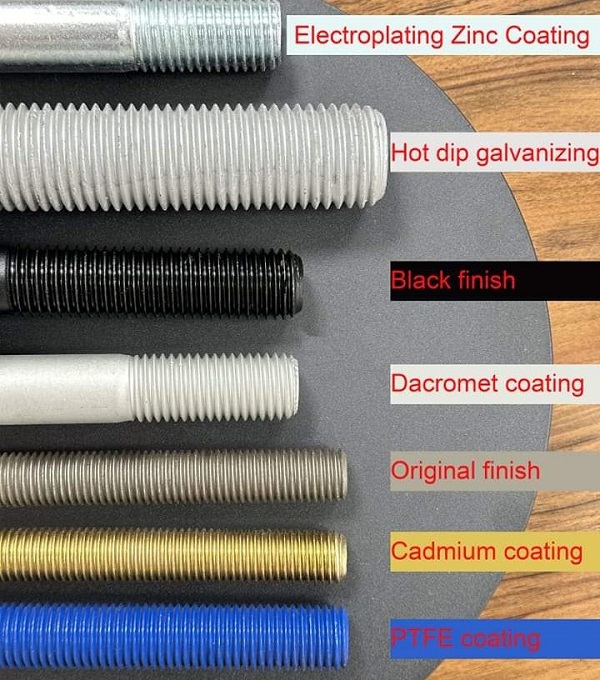Categories
- Pipe & Tube (18)
- Flange & Fitting (97)
- Fastener & Gasket (12)
- Valve & Pump (18)
- Base Material (11)
- Equipment (8)
- Application (30)
- Technical (110)
Large diameter steel flanges made in accordance with ASME B16.47 are bolted together to form a secure connection/ joint in piping and pipeline systems. This bolted flange joint is typically composed of two flanges, the gasket, full sets of bolting components. A set of the bolting components includes a stud bolt and two heavy hex nuts. The ASME B16.47 flanges are available in sizes NPS 26 through NPS 60 with pressure rating designations Class 75, Class 150, Class 300, Class 400, Class 600 and Class 900. These flanges can be further classified as Series A (MSS SP 44) and Series B (API 605). The size and quantity of stud bolts and nuts required for flange connections also vary depending on the size of the flange and its class designation.
A stud bolt is a type of fastener that is typically a threaded rod used in various industrial and construction applications. Unlike a traditional bolt that has a head, a stud bolt is essentially a metal rod with threads on both ends or along the entire length. The stud bolts shall be made in accordance with ASME B18.31.2. When used to tighten ASME B16.47 flanges, the stud bolt is working with two heavy hex nuts, that are manufactured in accordance with ASME B18.2.2. A heavy hex nut is a type of hexagonal nut that is thicker and has larger dimensions across flats than a standard hex nut. It is designed to provide greater strength and a larger bearing surface, making it suitable for high-stress applications. Stud bolts are usually designated with the size (diameter) and the overall length. The length of the stud bolts is determined by the flange thickness, gasket type, and the need to accommodate two nuts (one on each end). The diameter of the stud bolts is specified according to the flange size and pressure rating. The heavy hex nuts are usually designated with the size featuring key parameters such as thickness and across flats. Typically, the internal threading of heavy hex nuts shall match the threading of corresponding stud bolts. This threading is often coarse to provide a stronger hold.

Stud bolts and nuts for large diameter flange connections according ASME B16.47 Series A.
A set of stud bolt with two heavy hex nuts may be made from carbon steel, low alloy steel, or stainless steel. Based on different material grades, they can be classified as high strength, intermediate strength, and low strength. The typical material grades for stud bolts and nuts are listed in the table below.
| Bolt | Nut |
|---|---|
| ASTM A193 B7 | ASTM A194 2H |
| ASTM A193 B16 | ASTM A194 16 |
| ASTM A320 L7 | ASTM A194 4, 7 |
| ASTM A354 BC/BD | ASTM A563 A, B, C |
| ASTM A540 B21 | ASTM A194 16 |
| ASTM A540 B22 | ASTM A194 7/7M |
| ASTM A540 B23/B24 | ASTM A540 B23/B24 |
| ASTM A193 B5 | ASTM A194 3 |
| ASTM A193 B6 | ASTM A194 6/6F |
| ASTM A193 B8 | ASTM A194 8 |
| ASTM A193 B8M | ASTM A194 8M |
| ASTM A193 B8T | ASTM A194 8T |
| ASTM A193 S31254 | ASTM A194 S31254 |
| ASTM A320 B8 | ASTM A194 8T |
| ASTM A320 B8M | ASTM A194 8M |
| ASTM A320 B8C | ASTM A194 8C |
| ASTM A307 B | ASTM A563 B |
| ASTM A449 | ASTM A563 A, B |
| ASTM A453 660 | ASTM A453 660 |
| ASTM A453 651 | ASTM A453 651 |
| Boltings for Series A Flanges in Classes | ||
|---|---|---|
| 150# | 300# | 400# |
| 600# | 900# | - |
| Boltings for Series B Flanges in Classes | ||
|---|---|---|
| 75# | 150# | 300# |
| 400# | 600# | 900# |
To install a flange using bolts and nuts, you need to first ensure that the bolts, nuts, and flanges are of the correct size and specification for the job. Place the flange on the interface between the two pipes or devices that need to be connected. Next, pass the bolts through the bolt holes in the flange and attach the nuts. Use a wrench or socket wrench to rotate the bolts, gradually tightening them until the nuts and bolts securely connect the flange and the device. Finally, check the connection to ensure it is tight and there are no leaks or loose parts. It is important to follow relevant safety specifications and operating requirements to ensure the reliability and safety of the connection.
Common surface treatments for bolts and nuts include hot-dip galvanized, electrogalvanized, phosphate conversion coating, black oxide coating, and PTFE (Teflon) coating. Each treatment offers various benefits such as corrosion resistance, increased hardness, and non-stick properties. Additional coatings like epoxy, nylon, chrome plating, and dacromet coating can be chosen based on specific application needs to enhance durability and performance.

Different coatings for stud bolts and nuts.
